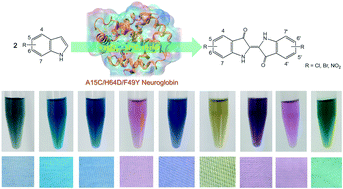Design and engineering of neuroglobin to catalyze the synthesis of indigo and derivatives for textile dyeing†
Abstract
The old dye indigo is still demanded worldwide, whereas chemical synthesis of indigo may cause environmental problems. Alternatively, the biosynthesis of indigo is an eco-friendly approach. In this study, by protein design and engineering, we showed that human neuroglobin (Ngb) can be converted into an enzyme capable of efficient synthesis of indigo from indole. Three mutations were rationally designed to stabilize the protein (A15C), enhance H2O2 activation (H64D), and facilitate electron transfer (F49Y), respectively. Kinetic studies and product analysis revealed that the triple mutant A15C/H64D/F49Y Ngb exhibits an activity much higher than those of the engineered myoglobin mutants, without the need of expensive cofactors required for cytochromes P450. This enzyme can also efficiently catalyze the coupling oxidation of indole derivatives containing –Cl/–Br/–NO2 groups, producing indigo derivative dyes, with a yield up to ∼90% and chemoselectivity up to ∼97%, respectively. Moreover, these synthesized dyes were successfully applied to dye cotton textiles with uniform colors such as blue, red, yellow, purple, and even green. Thus, we expect that the engineered enzyme of Ngb will have practical applications in the textile dyeing industry.

- This article is part of the themed collection: Sustainable fashion


 Please wait while we load your content...
Please wait while we load your content...